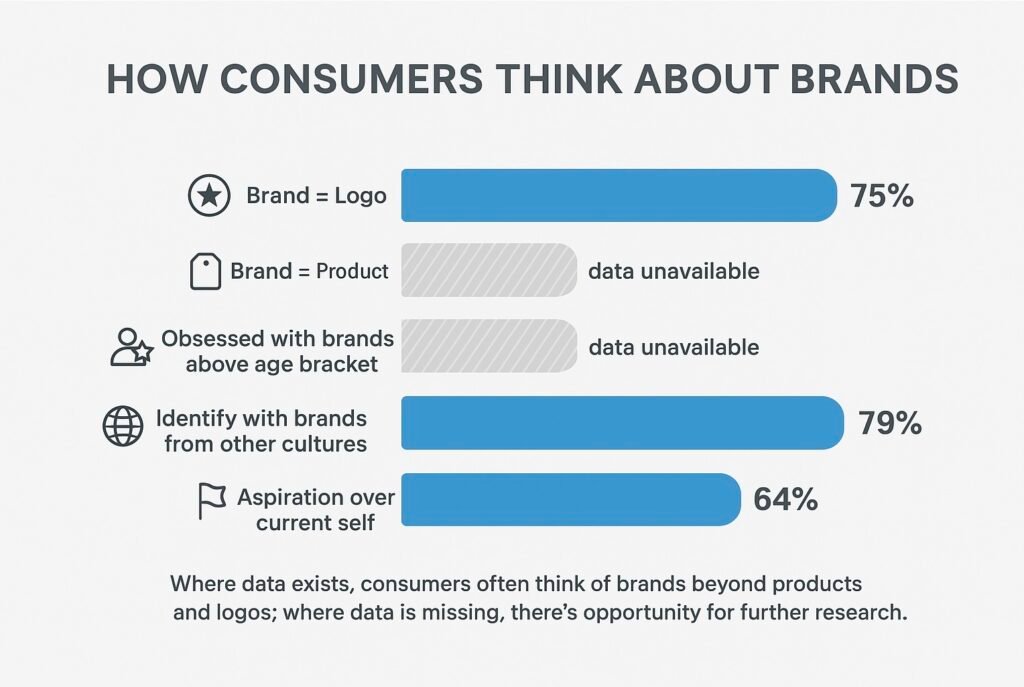Brand vs logo – 26% of adults are more likely to trust a company1 if they recognise its logo. But does that mean they have a genuine understanding of what the brand stands for?
It’s an assumption that everyone knows the exact definition of each and, thus, the difference. But do they? For many consumers, the boundaries between a brand, a logo, a product, and identity blur. This raises some fascinating questions:
- Do people believe that a brand consists entirely of its logo?
- Do they confuse the product with the brand?
- Do consumers aspire to brands beyond their age bracket or cultural background?
- Do people value brands for their current identity, or for the potential they offer for personal growth?
Do people really think a brand is just its logo?
Let’s be honest: a lot of people still do. They see a shiny mark on a website or packaging and think, “That’s the brand.”
But a logo is essentially the flag that represents a brand. It’s a shortcut for recognition, not the brand itself.
A brand lives in the feeling you get when you see that logo or hear that name. It’s the story, the tone of voice, how the product or service makes you feel, and the values it stands for.
Apple isn’t just a recognisable ‘bitten-into’ apple-shaped icon on your laptop lid. It shows innovation, sleek design, and reliability. It also gives off a subtle “I’m part of this club” vibe.
When people reduce a brand to its logo, they miss all the invisible work that goes into building trust, consistency, and reputation. A logo can open the door, but the experiences keep you returning.
Is a logo important – does it matter?
So yes, the logo matters—it’s the most visible element. But a brand is the whole ecosystem around it: how it looks, speaks, behaves, and makes people feel. The sooner we all understand that, the stronger our brands will be.
Do they confuse the product with the brand?
You can’t slap a new logo on a weak experience and expect loyalty.
This one’s even more common. We see a product and think it is the brand. But a product is the thing you buy, and the brand is the meaning you attach to it. These are two completely different things—even if they’re tightly linked.
Think about Coca-Cola.
On the surface, it’s sugar, bubbles, and caramel colour. But people aren’t just buying a drink. They buy “open happiness,” nostalgia, sharing, and tradition.
The drink is the delivery system. The brand is the feeling.
Or look at luxury goods.
A Chanel handbag is made of leather, stitching, and hardware – that’s the product. You’re buying the status, craftsmanship, and story of Coco Chanel herself. That’s why a bag with the same materials but no brand can’t command the same price.
It’s easy for companies to get this wrong, too. They think improving the product alone will automatically strengthen the brand. But without a clear story, a promise, and a relationship with customers, even the best product can feel generic.
A strong product supports the brand, but the brand—the trust, the meaning, the emotion—gives the product staying power.
Related reading: How to define your product
Do consumers aspire to brands outside of their age bracket or cultural demographic?
Here’s the thing: yes, they absolutely do.
Brands can reach beyond age, culture, and geography. They offer more than just products; they provide identity, aspiration, and a sense of belonging.
Think about Nike.
Their sneakers attract teens seeking style, middle-aged pros after comfort and status, and older adults who admired the brand in their youth. The product is the same—sneakers—but what people relate to varies: performance, self-expression, heritage, or “cool factor.”
Cultural boundaries are just as flexible.
A French skincare brand might become a must-have in Japan or the U.S., not because the ingredients are magically better, but because the brand story and image resonate globally.
People are drawn to brands that reflect qualities they admire or wish to show—like luxury, creativity, success, or sustainability.
Aspiration isn’t always about imitation or the surface-level stuff.
It’s all about aligning with the brand’s mission and a consumer’s subconscious.
What is on a brand’s surface matters
Someone might be in a demographic that the brand’s marketing doesn’t explicitly target, but if the brand represents a set of values or a lifestyle they desire, they’ll adopt it.
This is why brand perception research is so fascinating: it reveals the gap between who a brand thinks its audience is and who actually aspires to it.
So yes, people can engage with brands across age brackets, cultural lines, and socioeconomic categories.
Brands that understand this can expand their influence far beyond their core market—and connect with audiences in ways that feel personal, aspirational, and authentic.
Take a look at the data below for how logo and brand recognition occurs for various age groups.
I have to admit, I found it amusing – I assumed brand associations and the understanding of it, naturally started later in life, when critical thinking occurs.
I was surprised by the data—I didn’t expect to find toddlers in there.
But, if you think like an entrepreneur or strategist, you’ll know that segment (given the data) could become a massive business opportunity when looked at from the right angle.
| Age group | Brand recognition | Logo recognition | Gap analysis |
|---|---|---|---|
| Toddlers (3-5) | 10-20% | 91% (age 5) | 71-81% gap |
| Children (6-9) | 40-60% | High | Moderate gap |
| Teenagers (13-17) | 75-85% | High | Minimal gap |
| Young Adults (18-24) | 85-95% | High | No gap |
Finding: Logo recognition starts at 6 months, but brand narrative understanding doesn’t develop until the ages of 3-5.
Do people value brands for what they are, ie. what they stand for?
Now, here’s the kicker.
Do people really value brands for what they are, or just for what they represent?
It’s a bit of both, but mostly about what it symbolises or represents.
People rarely engage with a brand purely for the functional benefits of its products—they engage with what the brand means to them.
Take Tesla. Not the owner’s larger-than-life persona, but the product.
These cars are ahead of their time. But the brand’s true strength is its story: innovation, care for the environment, cutting-edge tech, and a bit of rebellion against the norm.
Tesla represents something aspirational, not just because it gets you from A to B—that is the attraction.
- Solopreneur vs Freelancer – what’s the difference; which one’s the best niche business model?
- Online Art Education Niche: Two $300 million opportunities hiding inside it. Untapped.
- Brand vs logo: Do consumers know the difference?
That said, some of the most enduring brands manage to balance identity (how the consumer and public visually identify with it) with substance.
People are quickly turned off to a brand if the experience or quality doesn’t match their perception of it. I know I am…
When a luxury brand skips on quality or a tech brand promises too much but delivers too little, they lose credibility fast, especially on social media.
The new loyalty is obsession.
Where does a brand’s value come from?
A brand’s value comes from this alignment (within itself):
- what the brand is,
- what it promises,
- and how consistently it delivers on that promise.
Ultimately, people value brands that feel authentic, reliable, and meaningful.
They want something to believe in, reflecting who they are or want to be.
A brand that understands and delivers this thoughtfully creates loyalty that is hard to shake.
It’s amazing how this psychological angle hasn’t changed through decades of marketing. I think it’s become even more emotional now via TikTok and YouTube content, ie. with the ‘storytelling’ form of communication.
Yes, storytelling has always been there as a marketing strategy, but I’m thinking specifically of those day-in-the-life videos. It’s inspiring every copycat out there to take up content creation. (I have a lot more to say on that topic in another post).
But, here’s the thing – these videos are inherently geared for implanting all kinds of marketing tactics in its scripts. The storytelling format (the daily updates) is a goldmine for not only creating loyalty, but downright obsession.
In part due to that, customers are no longer buyers, they’re becoming superfans depending on the level of that obsession with a brand.
Finding that data
As I was writing the above, I decided wanted to know more…from the facts and figures. In other words, what the data said.
So, to unpack this, I explored available research and consumer perception data.
While not every question has a perfect one-to-one statistic, some of the findings and proxies are useful in that it illuminates how people think about brands today.
For example: 80% of consumers value brand authenticity, while 78% bond with brands offering aspirational content. That’s pretty close.
Why do you need to know this?
Well, if you’re thinking about starting a niche content site or brick-and-mortar business, or a hybrid, you’ll need to know that successful brands balance both elements, ie. authenticity and aspirations.
This, among many other factors, will affect how you engineer your brand strategy, it’s personality and tone. All factors that can eventually affect your bottom line.
What the data shows about a brand versus a logo
The tables below show how users interact with brands and logos. The gaps are interesting because it indicates there’s research to be done. Fun times…
How many users think a brand and a logo are the same thing?
| Data | 75% of people say logos make brands more identifiable and recognisable |
| 75% of consumers recognise a brand by its logo alone 2 | |
| 65% of people between 45–54 years old often recognise logos of big brands. | |
| Comment | These stats show strong logo recognition. Doesn’t prove people literally think “logo = brand.” Recognition ≠ definition. |
How many users think a product and a brand are the same thing?
| Data | No clear statistic. |
| Comment | Closest examples: people referring to products by brand names (e.g., referring to a tissue as a ‘Kleenex’) |
| Gap | There are no direct numbers. Consumer perception surveys would need to ask this explicitly. |
Parallel insight:
- Product categories become secondary to brand identity in consumer minds
- 77% of consumers use brand names instead of product names, indicating deep brand-product conflation.
How many users are obsessed with brands above their age bracket?
| Data | No direct data are available |
| Gap | Likely filled by studies on aspirational consumption, luxury/status brand desire, and youth marketing |
Parallel insight:
- Brand understanding follows a developmental progression, with young adults showing peak brand comprehension.
- Aspirational messaging resonates strongest with 18-24 age group
- How to Start a Profitable Cleaning Niche Blog: 10 Sub-Niches you can monetise
- How to define your product: You’ll have one when you know what you stand for
- Infographics promote longer session time – here’s why readers hang around
How many users identify with brands from a different culture than their own?
| Data | 79% of consumers agree that brands are positioned to connect people of varying backgrounds and beliefs |
| 63% of customers say that brand matters greatly in smartphone shopping | |
| 53% in clothing and shoes | |
| Comment | These suggest brands as cultural ‘unifiers’ |
| Gap | No one directly measures identification with cross-cultural brands |
How many users care more about a brand that promises what they could be, as opposed to what they already are?
| Data | 40% of “Aspirationals” seek style and social status |
| 84% find shopping exciting and prefer purposeful brands | |
| 64% of consumers cite a shared value system as the primary reason for brand loyalty | |
| Comment | It suggests that people tend towards aspirational branding (ideal self) rather than purely affirming their current self |
| Gap | No single number exists comparing ‘aspirational’ vs. ‘self-affirming’ |
Parallel insight:
- 80% of consumers value brand authenticity, while 78% bond with brands offering aspirational content.
- Consumers want authenticity (what they are), but also want aspiration (what they could be)

Conclusion – Why This Matters
Looking at these data points, one thing becomes clear:
Brand perception is fluid.
Depending on whom you ask, a brand can be a logo, a product, a status symbol, a cultural connector, or a personal aspiration.
For marketers and brand-builders, this is both an opportunity and a challenge. If consumers define “brand” differently, then clarity of communication becomes essential. Does your audience see you as just a logo or something bigger? Do they aspire to what you stand for, or use your product?
Until more precise consumer surveys are conducted, these proxies at least highlight the tension between recognition and meaning. A brand is not static—it shifts in the consumer’s mind, sometimes in ways research hasn’t fully captured yet.
Sources
1. Logo recognition statistics – Renderforest, StudyFinds
2. Brand recognition by age group – Ipsos
3. Consumer values and brand loyalty – Harvard Business Review, Edelman Trust Barometer
4. Aspirationals study – BBMG / GlobeScan
5. Cross-cultural brand connection – Wunderman Thompson, Nielsen
1 “10 Link Building Benefits (Not Just SEO).” Outreach Labs, 27 Nov. 2022, staging.outreachlabs.com/link-building/resources/link-building-benefits/. Accessed 24 Sept. 2025.
2 “Beauty Brand Logos: Design Tips & Branded Image Ideas.” Whatever Logo, 16 Mar. 2025, staging.outreachlabs.com/link-building/resources/link-building-benefits/. Accessed 25 Sept. 2025.
Disclosure: While this blog uses AI tools for data collection and analysis support, the research questions, hypotheses, and core insights are my original work. AI assists with information processing, but all conceptual thinking, interpretation, and conclusions reflect my professional expertise.

